- Author
- A.N. Other
- Subjects
- History - general
- Tags
-
- RAN Ships
- None noted.
- Publication
- March 2018 edition of the Naval Historical Review (all rights reserved)
By John McGrath
Captain John McGrath, RN is a retired officer with a lifelong interest in naval swords. With Mark Barton he co-authored British Naval Swords and Swordsmanship published by Seaforth in 2013. This article has been especially prepared for the benefit of an Australian audience affords considerable benefit as a reference.
The first swords with an indisputable maritime provenance are those recovered from the wreck of the Mary Rosewhich sank at Spithead in 1545 while engaging the French. Among the many weapons recovered from the mud of the Solent were one complete sword and several fragmentary weapons. These are all basket-hilted broadswords typical of the time and there is no way of determining whether they belonged to seamen or to soldiers. They almost certainly belonged to officers because there is no mention of swords in the list of stores held on board. Later in the sixteenth century we have the sword attributed to Sir Francis Drake, still owned by the Drake family and on loan to the Wardroom of HMS Drakein Devonport, Fig. 1. There is no visible indication that this was a maritime weapon; it is a characteristic, high quality fighting sword of the period.

This lack of distinction for naval swords persisted throughout the seventeenth century and on into the eighteenth. In the first half of the eighteenth century, the most popular style of sword carried by naval officers was a short weapon with either a curved or a straight blade. Today such swords are referred to as hangers and hunting swords respectively but this clear cut distinction between the two is modern. Both types generally had a rounded pommel, a simple knuckle bow for a guard and a turned down, shell shaped guard. From both a naval and an Australian perspective, possibly the most interesting example of these types is the silver-hilted sword of James Cook, now preserved in the State Library of New South Wales, Fig. 2.

It is necessary to remember that during the period leading up to the end of the eighteenth century every gentleman would have worn a sword and naval officers were no exception. While the wearing of swords declined in civilian life, it continued unabated by officers of both the navy and the army and it is at this juncture that clear indications of naval provenance start to appear in the shape of recognisably naval motifs such as the fouled anchor and the naval crown.
Short, curved fighting swords were popular with both services and these often had hilts with ebony grips, sometimes bound with copper tape, guards with two side bars, and olive shaped pommels. Many are plain and not attributable with certainty to either service but some have fouled anchors decorating their pommels making their naval provenance clear, Figs. 3a and b. An inscription of the back edge of this weapon reads: WARRANTED NEVER TO FAIL 1791, firmly dating this sword.

There were numerous designs, reflecting both the tastes and the pockets of their owners. Probably the best know was the five ball sword, so named for the globules on both the knuckle guard and the side ring, Fig. 4. Fitted with a straight, cut and thrust blade, it was popular with both services and naval examples can be recognised by the fouled anchor, sometimes crowned, as here, on the ‘cigar band’ around the grip and by the fouled anchor supporting the side ring on many examples.
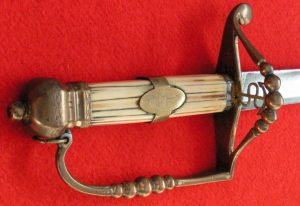
Fig 4. Five ball sword ca 1800
The swords just looked at were fighting weapons but, when ashore, some officers would follow civilian practice and wear a small-sword. A lightweight derivative of the rapier, it began life in the mid-seventeenth century and evolved into the court sword still worn by some officials today. Those belonging to naval officers can only be recognised if they have naval emblems in their decoration. Such is the unmarked, silver hilted small-sword illustrated in Fig. 5. The tiny fouled anchors set into the arms of the hilt proclaim its owner’s profession in the most restrained and tasteful manner. It must have been specially commissioned from a cutler and would have been an expensive item, possibly belonging to a flag officer.
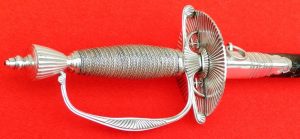
Fig. 5. Silver hilted small-sword with fouled anchors set in the arms of the hilt, ca 1790.
This laissez faire attitude to swords was to change in 1805 when two patterns were introduced. For officers of commander’s rank and above there was the ornamented sword with a cut and thrust spadroon blade, a gilt stirrup hilt with langets bearing a fouled anchor, a white ivory grip, and a pommel in the form of a lion’s head, Fig. 6. Although the blade of this specimen is plain, many were beautifully blued and gilt. The ‘D’ buckles for suspension are an early design, rapidly replaced by the more familiar loose rings.

Fig. 6. 1805 Pattern, Ornamented, for Commanders and above.
For Lieutenants and below there was a plain version with a grip covered in black fish skin and a plain, rounded pommel, Fig. 7. The blades of these were only rarely blued and gilt, decoration being confined to engraving.
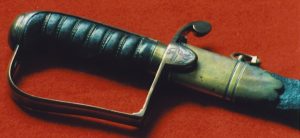
Fig. 7. 1805 Pattern, Plain for Lieutenants, Midshipmen and Warrant Officers.
These swords seem to have been designed on the ‘pick and mix’ principle with the blade of the 1796 Pattern infantry sword combined with the stirrup hilt of the 1796 Pattern light cavalry sword and the lion’s head pommel of the 1803 Pattern for grenadiers and flank companies. Later, the crown appeared above the anchor but there is no specific date for this development. Weapons that combine the black grip of the plain sword with the lion’s head pommel of the ornamented version are not uncommon and usually attributed to Lieutenants wishing to emphasise their commissioned status.
The days of the small-sword as a dress weapon were numbered, it being replaced by lightweight and often highly decorated versions of the uniform sword, Fig. 8.

Fig. 8. A richly decorated, dress version of the 1805 Pattern. This sword was retailed by John Salter, Sword Cutler to HRH the Duke of Sussex, one of the most prestigious sword cutlers of the time.
In 1825, a new pattern of sword based on the obsolete small-sword was introduced for the three civil branches of Secretaries to Admirals, Pursers, and Surgeons, Fig. 9. The idea behind this move seems to have been to emphasise the non-executive status of these people. Each branch was identified by its badge: Secretaries the crowned and fouled anchor of the Navy Office; Pursers the crossed fouled anchors of the Victualling Office; Surgeons the anchor entwined by a snake of the Sick and Hurt Office. This sword lasted only until 1832 making it one of the rarer patterns.
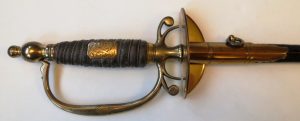
Fig. 9. Small-sword of the civil branches, 1825 – 32, Purser’s Pattern
In 1822 the Army introduced a completely new sword for its infantry officers and the RN followed suit with a very similar weapon five years later, Fig. 10. With this sword, the main features of today’s weapons are clearly recognisable.

Fig. 10. 1827 Pattern sword worn by all officers and also midshipmen
The blade was of a style known to modern collectors as pipe-backed, ramrod-backed or quill-backed. It was supposed to be equally good for cutting as for thrusting. However, while the reinforced back edge certainly stiffened the blade for a thrust, it impeded its passage through clothing and flesh in the cut. The half-basket hilt in the Gothic style with the crowned and fouled anchor in the oval cartouche was solid between the bars, unlike the Army’s version which was open and had proved fragile in combat. The grip remains white but the ivory has been replaced by a wooden core covered in fish skin and the lion’s head pommel has been retained but in a more naturalistic form. Until 1832, the scabbard had only two mounts as the sword was worn in a frog on a cross belt. In that year the familiar two loose rings reappeared. The sword knot was also different, terminating in a tassel of twelve individual gold bullions, Fig. 11.
Fig. 11. 1827 Pattern showing frog hook and sword knot ot
ot
The sword for warrant officers and masters-at-arms was similar but with the black fish-skin covered grip and the rounded pommel. The sword knot was also plain blue.
Flag officers swords were distinguished by bands of oak leaves among the engraving on each of the scabbard mounts. However, in 1831 the Army had adopted a mameluke-hilted dress sword for its general officers and the RN followed suit in 1842 with a similar sword for optional wear by flag officers, Fig. 12.

Fig. 12. 1842 Pattern for optional wear by Flag Officers, courtesy of the present owner
This pattern was withdrawn in 1856 but there is evidence that even officers promoted after that date continued to wear it.
The Army replaced the thoroughly inefficient pipe-backed blade by a flat-backed design in 1845 but it was another year before RN followed suit. The resultant sword is still with us today but with a narrow, straight blade rather than the earlier slightly curved and broader weapon, Fig. 13.

Fig. 13 1846 Pattern officers’ sword
Since 1805 there have been 11 different patterns of scabbard, 6 different sword knots and 27 sword belts. These are far too numerous to cover here but full details can be found in numbers 5 and 7 of the Bibliography. Fig 14 gives a flavour of the variety of sword belts with an example of each of the four patterns introduced in 1891.
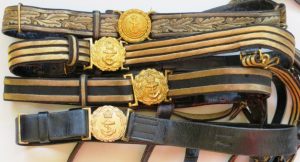
Fig 14. From top to bottom: Full dress belts of flag officers, senior officers, junior officers and the undress belt of all officers. When swords were restored after WWII, only flag officers retained full dress. However the belt embroidered with oak leaves and acorns was reserved for Admirals of the Fleet while other flag officers wear the belt with three gold lines. Since 1996 the rank of Admiral of the Fleet has been in abeyance and the wearing of the oak leaf belt has been extended to Chief of the Defence Staff, if a flag officer, First Sea Lord and to flag officers holding a few other specific appointments.
A word or two about the crown which accompanies the fouled anchor in the designs in the cartouche on the guard and etched on the blade might be appropriate. The two most frequently encountered designs are the St Edward’s Crown and the Tudor Crown. In the former of these, the arches supporting the orb and Cross are depressed towards the centre. This design, often erroneously termed a Queen’s Crown by collector, has been used as the regal crown by Queen Elizabeth II, Queen Victoria and the monarchs preceding her. The arches of the Tudor Crown rise towards the centre to support the orb and crown. This design was used by Edward VII, George V, Edward VIII and George VI. Collectors often refer to this as a King’s Crown. The Sovereign chooses the regal crown and it will be interesting to see which design is chosen by Prince Charles on his accession. Images of other types such as the Imperial State Crown and the Guelphic Crown are encountered but very rarely.
Because the RAN has kept to the design of the RN sword, it is only if there is some additional evidence, such as a name engraved on the guard or family tradition, that one can be linked with an Australian provenance. One very interesting exception to the general rule has very recently been brought to the attention of the author: the sword of Captain Edward Richard Connor, CMG, RN. This sword, with its blade etched for the New South Wales Naval Brigade, Fig. 15, is owned by his great grandson. He speculates about the possibility that swords of the Victoria, South Australia and Queensland naval forces were similarly etched.

Fig. 16. Sword of the Royal Naval Brigade, New South Wales, courtesy of the present owner
Edward Connor was born 11 February 1846 at Blean, Kent, and entered the RN in 1861 as a Master’s Assistant working his way to Lieutenant and specialising in hydrographic surveying. This took him to Queensland where he married. On his retirement from the RN in 1880 he returned to England. In 1883 he returned to New South Wales and joined the Naval Brigade as a Lieutenant. On 8 August 1900 Commander Edward Connor embarked for China in HM Transport 105, SS Salamis, Fig. 16. He commanded the NSW Naval Brigade, part of the Australian contingent helping to suppress the Boxer Rebellion. They returned home in HM Transport 106, SS Chingtubut, because of an outbreak of smallpox in China, were placed in quarantine and finally landed in Sydney on 3 May 1901. During their absence, the colonies had federated as the Commonwealth of Australia. Captain Edward Connor CMG died at his home in Sydney on 2 January 1903 aged 56.
Dirks and cutlasses are specialist topics in their own rights but one myth really needs to be corrected. The uniform weapon of the midshipman has not always been a dirk. Up until 1805 when regulations were first promulgated, they could wear weapons of their choice. From that date until 1856, whatever novelists and the cinema say, they were instructed to wear swords.
Bibliography
- Annis, P.G.W., Naval Swords, British and American Naval Edged Weapons, 1660 1815(London: Arms and Armour Press, 1970).
- Bosanquet, T.A., Captain RN, The Naval Officer’s Sword(London: Her Majesty’s Stationery Office, 1955).
- Comfort, Sim, Naval Swords & Dirks(London: Sim Comfort Associates, 2008).
- Gilkerson, William, Boarders Away with Steel – Edged Weapons & Polearms(Lincoln, Rhode Island: Andrew Mowbray, 1991).
- May, W.E., Commander RN and Annis PGW, Swords for Sea Service(London: Her Majesty’s Stationery Office, 1970).
- May, W.E., and Kennard, A.N., Naval Swords and Firearms(London: Her Majesty’s Stationery Office, 1962).
- McGrath, John and Barton, Mark, British Naval Swords & Swordsmanship(Barnsley, Seaforth Publications, 2013).
- Verity, Liza, Naval Weapons(London: National Maritime Museum, 1992).
- Wolfe, Sarah C., Naval Edged Weapons(London: Chatham Publishing and Pennsylvania: Stackpole Books, 2005).




